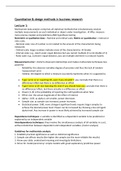Summary
Summary Quantitative & design methods in business research
- Course
- Institution
This is a summary and collection of notes from all the lectures and micro-lectures. Also, the answers to the practice questions are included. The subjects are: 1. Introduction lecture, 2. Factor analysis, 3. ANOVA, 4. Regression analysis And 5. Structural Equation Modeling (SEM)
[Show more]



